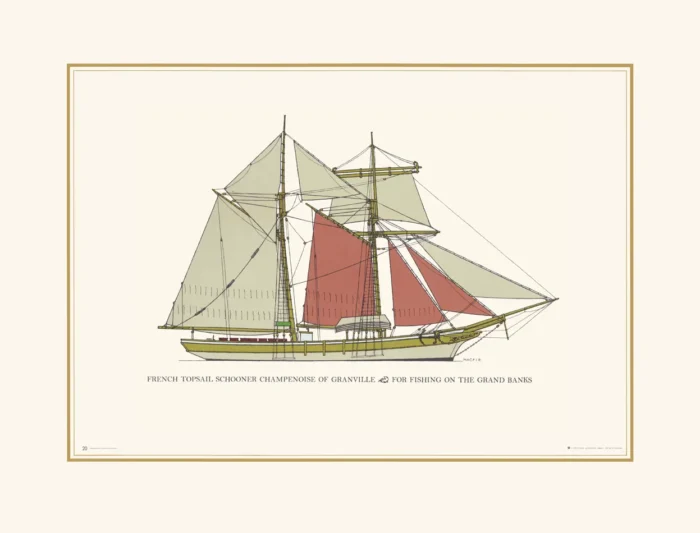French Topsail Schooner for Fishing on the Grand Banks, Champenoise de Granville, 1887
Original price was: £20.00.£12.50Current price is: £12.50.
Grand Banks schooner: for fishing off Newfoundland (scroll down for a more detailed Description)
Published 1963 by Hugh Evelyn; drawn by Swedish marine artist Gordon Macfie (1910-1971) for Tre Tryckare of Gothenburg (who retain copyright)
Print size: c 44 cm x 33.5 cm [17½″ x 13″] (may vary slightly from printers’ cut 50 years ago)
Printed on light orange (RGB c. fdf1dd) cardstock c. 300 g/sm2
Print is LARGE size – shipping is the same for 1 to 10 prints (based on largest print size in your order) – see Shipping & Returns
In stock
Description
On the continental shelf, between the warm waters of the Gulf Stream and the cold flow of the Labrador Current, shallow plateaus called banks are fertile grounds for marine life. For more than 500 years, fishermen have come to the banks seeking the natural bounty of cod, haddock, halibut, and other fish. Sailing from the principal New England fishing ports of Gloucester and Boston, vessels worked all these waters, from Georges Bank 100 miles east of Cape Cod, to the Grand Bank of Newfoundland, 800 miles east-northeast of Gloucester. They were to be joined by vessels from Europe who placed their catch in salt for preservation. When fishermen began to work shallow, rough Georges Bank in the 1830s, it was the most productive fishing bank in the North Atlantic. A schooner is a sailing vessel with fore-and-aft sails on two or more masts. The most common type has two masts, the foremast being shorter than the main. The first detailed definition of a schooner, describing the vessel as two-masted vessel with fore and aft gaff-rigged sails appeared in 1769 in William Falconer’s, Universal Dictionary of the Marine.
Additional information
| Weight | 0.0292 kg |
|---|---|
| Dimensions | 44 × 33.5 cm |





